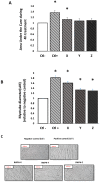A Cell-Based Assessment of the Muscle Anabolic Potential of Blue Whiting (Micromesistius poutassou) Protein Hydrolysates
- PMID: 36768324
- PMCID: PMC9916327
- DOI: 10.3390/ijms24032001
A Cell-Based Assessment of the Muscle Anabolic Potential of Blue Whiting (Micromesistius poutassou) Protein Hydrolysates
Abstract
Blue whiting (BW) represents an underutilised fish species containing a high-quality protein and amino acid (AA) profile with numerous potentially bioactive peptide sequences, making BW an economic and sustainable alternative source of protein. This study investigated the impact of three different BW protein hydrolysates (BWPH-X, Y and Z) on growth, proliferation and muscle protein synthesis (MPS) in skeletal muscle (C2C12) myotubes. BWPHs were hydrolysed using different enzymatic and heat exposures and underwent simulated gastrointestinal digestion (SGID), each resulting in a high degree of hydrolysis (33.41-37.29%) and high quantities of low molecular mass peptides (86.17-97.12% <1 kDa). C2C12 myotubes were treated with 1 mg protein equivalent/mL of SGID-BWPHs for 4 h. Muscle growth and myotube thickness were analysed using an xCelligence™ platform. Anabolic signalling (phosphorylation of mTOR, rpS6 and 4E-BP1) and MPS measured by puromycin incorporation were assessed using immunoblotting. BWPH-X significantly increased muscle growth (p < 0.01) and myotube thickness (p < 0.0001) compared to the negative control (amino acid and serum free media). Muscle protein synthesis (MPS), as measured by puromycin incorporation, was significantly higher after incubation with BWPH-X compared with the negative control, but did not significantly change in response to BWPH-Y and Z treatments. Taken together, these preliminary findings demonstrate the anabolic potential of some but not all BWPHs on muscle enhancement, thus providing justification for human dietary intervention studies to confirm and translate the results of such investigations to dietary recommendations and practices.
Keywords: C2C12 cells; blue whiting protein hydrolysates; muscle growth; muscle protein synthesis.
Conflict of interest statement
The authors declare no conflict of interest. The funders had no role in the design of the study; in the collection, analyses, or interpretation of data; in the writing of the manuscript, or in the decision to publish the results.
Figures




Similar articles
-
Physicochemical, technofunctional, in vitro antioxidant, and in situ muscle protein synthesis properties of a sprat (Sprattus sprattus) protein hydrolysate.Front Nutr. 2023 Jun 23;10:1197274. doi: 10.3389/fnut.2023.1197274. eCollection 2023. Front Nutr. 2023. PMID: 37426190 Free PMC article.
-
A Fish-Derived Protein Hydrolysate Induces Postprandial Aminoacidaemia and Skeletal Muscle Anabolism in an In Vitro Cell Model Using Ex Vivo Human Serum.Nutrients. 2021 Feb 17;13(2):647. doi: 10.3390/nu13020647. Nutrients. 2021. PMID: 33671235 Free PMC article.
-
Exploring the Physicochemical Characteristics of Marine Protein Hydrolysates and the Impact of In Vitro Gastrointestinal Digestion on Their Bioactivity.Mar Drugs. 2024 Oct 1;22(10):452. doi: 10.3390/md22100452. Mar Drugs. 2024. PMID: 39452860 Free PMC article.
-
Dietary proteins and amino acids in the control of the muscle mass during immobilization and aging: role of the MPS response.Amino Acids. 2017 May;49(5):811-820. doi: 10.1007/s00726-017-2390-9. Epub 2017 Feb 7. Amino Acids. 2017. PMID: 28175999 Review.
-
The Potential Role of Fish-Derived Protein Hydrolysates on Metabolic Health, Skeletal Muscle Mass and Function in Ageing.Nutrients. 2020 Aug 13;12(8):2434. doi: 10.3390/nu12082434. Nutrients. 2020. PMID: 32823615 Free PMC article. Review.
Cited by
-
Antioxidative, Glucose Management, and Muscle Protein Synthesis Properties of Fish Protein Hydrolysates and Peptides.J Agric Food Chem. 2024 Oct 2;72(39):21301-21317. doi: 10.1021/acs.jafc.4c02920. Epub 2024 Sep 19. J Agric Food Chem. 2024. PMID: 39297866 Free PMC article. Review.
-
Nutritional strategies for improving sarcopenia outcomes in older adults: A narrative review.Pharmacol Res Perspect. 2024 Oct;12(5):e70019. doi: 10.1002/prp2.70019. Pharmacol Res Perspect. 2024. PMID: 39400516 Free PMC article. Review.
-
Physicochemical, technofunctional, in vitro antioxidant, and in situ muscle protein synthesis properties of a sprat (Sprattus sprattus) protein hydrolysate.Front Nutr. 2023 Jun 23;10:1197274. doi: 10.3389/fnut.2023.1197274. eCollection 2023. Front Nutr. 2023. PMID: 37426190 Free PMC article.
-
Optimizing Protein Bars With Whey Protein Isolate, Pea Protein Isolate, and Blue Whiting (Micromesistius poutassou) Fish Protein Hydrolysate: A Simplex-Centroid Mixture Design Study.Food Sci Nutr. 2024 Dec 19;13(1):e4701. doi: 10.1002/fsn3.4701. eCollection 2025 Jan. Food Sci Nutr. 2024. PMID: 39803272 Free PMC article.
-
Dietary protein considerations in a sustainable and ageing world: a narrative review with a focus on greenhouse gas emissions and skeletal muscle remodelling and maintenance.BMC Musculoskelet Disord. 2024 Dec 19;25(1):1030. doi: 10.1186/s12891-024-07945-6. BMC Musculoskelet Disord. 2024. PMID: 39702220 Free PMC article. Review.
References
MeSH terms
Substances
Grants and funding
LinkOut - more resources
Full Text Sources
Medical
Miscellaneous

